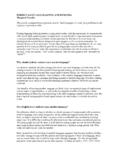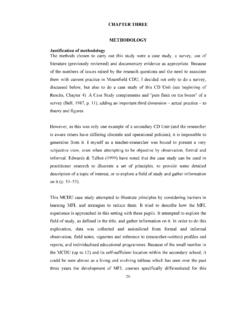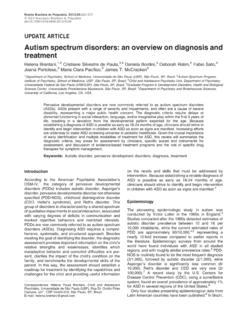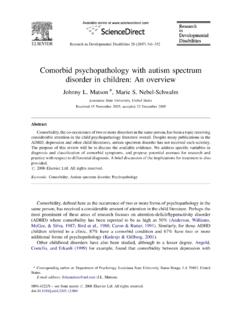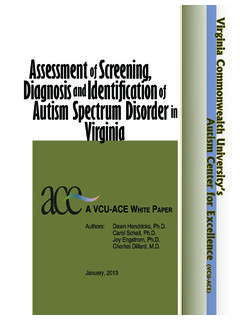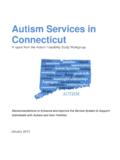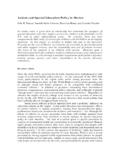Transcription of Autistic Spectrum Disorders and learning foreign …
1 This is an electronic version of an Article published in Support for learning , the British Journal of learning Support, Volume 20, Number 3, August 2005. NASEN 2005 Autistic Spectrum Disorders and learning foreign languages Vivienne Wire Abstract The number of young people with a diagnosis of an Autistic Spectrum Disorders (ASD) coming into mainstream foreign languages classes is increasing, and this is causing some concern to teachers. Based on her extensive professional experience, Vivienne Wire here considers the implications for teaching and learning of the triad of impairments found in pupils with autism and discusses strategies for intervention. In addition, positive aspects of an Autistic person s style of learning are suggested, which may help classroom relationships, pupil motivation and behavioural issues. It is hoped that the issues raised in this article will promote the importance to young people with autism of learning a foreign language and explain how issues of structure and organisation, which lie beyond the triad, are of equal significance in meeting the needs of children and young people with autism .
2 Introduction Across the UK, as elsewhere, teachers are finding more pupils with autism coming into their foreign languages classrooms. These young people are likely to have a diagnosis of Asperger syndrome or high functioning autism , and for the majority of teachers who have received little or no training in strategies for this group; their arrival in ever increasing numbers is causing some concern. autism is a lifelong pervasive developmental disorder, or rather a Spectrum of Disorders , which most likely includes Asperger syndrome. Disorders on the Spectrum have in common three particular areas of difficulty - an impairment in social interaction, in social communication, and in imaginative and flexible thinking. This article aims to provide a little of the background to Autistic Spectrum Disorders (ASD) and to suggest some strategies which may be helpful both to foreign language teachers and to their learners with autism .
3 Background In secondary schools, there is still a significant tranche of teachers who trained in the late 1960s/early 1970s, at a time when autism had been identified officially for less than 25 years and Asperger syndrome was almost completely unknown. The psychologists, Leo Kanner in the USA (1943) and Hans Asperger in Austria (1944), published their research independently of each other on groups of young people with characteristics now called Autistic . autism the word coming from the Greek word for self had probably always existed, and indeed there are earlier, fragmented reports worldwide of people displaying Autistic characteristics. But as Kanner s research findings were scientifically validated, his writings have become the benchmark for classic low-functioning autism . Asperger, on the other hand, who had written in German describing his focus group, received little plaudit or acknowledgement until his findings were translated and discussed by Wing (Wing and Gould, 1979; Wing, 1981), when they were greeted with great interest.
4 Controversy about the causes, prevalence and diagnostic criteria for what are now most often referred to as Autistic Spectrum Disorders (ASD) continues, but discussion of these is not relevant here. It is perhaps worth commenting that a diagnosis of autism is more likely than formerly. A greater awareness among a range of professionals whose work brings them into contact with children and young people will be playing some part in the rise of those diagnosed. However, recent figures suggest the current prevalence rate in the UK population for all those with ASD is at least as high as 1:147 (Fombonne, 2001). Fombonne s research also documents an increase of 1300% over the past twenty-five years. Thus it is likely that ASD is here to stay and, as recent legislation has introduced a presumption of mainstreaming, it may be useful to raise awareness of potential issues for teachers of pupils with autism so that both teacher and pupil have a really positive experience in a foreign language class.
5 Pupils now coming into mainstream schools are likely to be diagnosed with high functioning autism or Asperger syndrome. Asperger syndrome, described by Frith (1991) as a dash of autism , is the diagnosis where, alongside other specific criteria, language develops normally, even precociously, in a young child. High-functioning autism is a relative term, given to the minority of those diagnosed as Autistic who do not have considerable learning difficulties. It is important to think of autism as a Spectrum , but also to remember that wherever someone is placed on the Spectrum , there is always the so-called triad of impairments (Wing, 1996). This is the crux of autism and, as it is evident even in those with a very high level of cognitive ability, therefore requiring acknowledgement on the part of the teacher, the three aspects of the triad will now be discussed. In this article, I use the personal pronoun he/his (there is a ratio of around four male: one female at the higher functioning end of the Autistic Spectrum ) but she/her is intended as well.
6 The triad of impairments First, in autism there is always an impairment in social interaction. This means a difficulty in social conversation and quite often discomfort around others, resulting in an off-hand or rude social manner. There may be a disinterest even dislike of working in a group or pair and a strong preference for being allowed to work independently and alone. learning a foreign language can make a useful contribution to raising an Autistic pupil s awareness of social skills, right from early attempts at social meetings and greetings . Modelling and prompting by the teacher and selected pupils and the strategies described later may be helpful. The second aspect of the triad is unusual social communication. This means these pupils voices may be too soft or loud, they may have speech that is garbled and long-winded, or too brief, and there may be elective muteness, or echoing of words and phrases.
7 Some find direct eye contact with others difficult, even painful, and may focus on the mouth or a point beyond the face, but this does not mean they are not noticing everything through their peripheral eye vision. In a subject such as foreign languages where oral communication is so important, patience and prompting are required, but this subject has the potential to help the pupil with autism communicate more appropriately, as all pupils have to demonstrate their ability to understand others and equally be understood by them. The third aspect of the triad is a lack of flexibility, which can be seen in varying ways. Perhaps an important issue for the classroom teacher is the real difficulty most pupils with autism have in coping with change. It may well take them time to get used to a new school, new teachers and possibly a new subject. These pupils may not like it if a supply teacher takes over and varies the routine, so prior warning to the pupil can help.
8 The challenge many have with change is displayed daily, even hourly, in school, for example when the bell rings and there is a change of location and lesson. Pupils with autism find it particularly hard to adjust first thing in the day, when they are making the transition from home to school, and they may be quite uncooperative during the first lesson of the day. Changes throughout the day will affect them, for example, going from PE to French (often slow to get changed, because of organisational issues); break/lunchtime to French (going from unstructured time, which they don t always enjoy, to a structured lesson); science to French (different area of school, so they may get lost, or teased going along corridors or across the playground). In these examples, the pupil with autism may arrive at the languages class highly distracted. If there are a lot of instructions in the foreign language from the teacher, without some kind of visual support on the board, it is likely that he, and perhaps a few others in the class, may get behind since some find processing such verbal information difficult.
9 This pupil may not have heard, and cannot then follow, the instructions already given, and may anger the teacher by speaking back when challenged to get organised quickly . It is possible that he will still be trying to find textbooks and exercise books in his packed schoolbag (which probably has not been cleared of school letters home and PE kit to be washed!) when everyone else has started on the first task. Once started, his pace in doing the tasks may be slower than others and he may need prompting and motivating to continue. The result can be that the pupil gets more and more behind, and frustration and stress build up for pupil and teacher. Sometimes the end result is the pupil being withdrawn from the languages class an unnecessary and undesirable outcome. An awareness of this particular difficulty for pupils with autism may assist the teacher to support these pupils appropriately at times of transition. The lack of flexibility may also be displayed in a strict appliance of rules either classroom/school ones or his own.
10 This is not a pupil who knowingly breaks established classroom rules and his adherence to rules can make him unpopular with his peers and liable to retaliation later. A hand may be readily raised to tell on the boy at the back who is not following instructions or is touching a piece of equipment which pupils are not supposed to touch. This tendency needs careful supervision: for example by directing such a pupil to have a quiet word with you, the teacher, only when pupil safety is threatened, and not during lesson time. Often this pupil does not want anyone else writing in his exercise book, or using a different colour of pen or pencil. His pencils and books may be neatly lined up on the desk. He may become upset if he cannot sit in a particular chair, even though to anyone else they all look like identical black plastic chairs. Many have a very literal understanding of words and phrases and have a difficulty understanding that these sometimes have more than one meaning.
